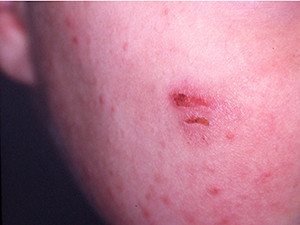Gianotti-Crosti Syndome
This syndrome shows a papular acrodermatitis of children and is also known as 'papulovesicular acrolated syndrome' and 'papular acrodermatitis of childhood'. The aetiology is unknown but is assumed to be associated with the Hepatitis B or Epstein-Barr-Virus. The classic finding shows a multiple red-brown, pruritic papulovesicular exanthema mostly located on the extremities and the face. The papules can be partly confluent. It starts abruptly and may be accompanied by hepatosplenomegaly, lymphadenopathy, pharyngitis, tonsillitis or fever. Enanthema in the oral cavity are possible. The condition is self-limiting within 4 to 8 weeks.
Pathogen: unknown, associated with hepatitis B virus or Epstein-Barr virus
Transmission path: droplet infection (if viral ethiology)
Incubation time: depending on the ethiology
Contagiousness: until the exanthema shows up
Prodromal symptoms: sometimes pharyngitis, upper-airway infection or diarrhea
Symptoms: papulovesicular exanthema, casually associated with tonsillitis, lymphadenitis, pharyngitis, fever
Treatment: symptomatically
Complications: Liver infection, reduced liver function back
Pathogen: unknown, associated with hepatitis B virus or Epstein-Barr virus
Transmission path: droplet infection (if viral ethiology)
Incubation time: depending on the ethiology
Contagiousness: until the exanthema shows up
Prodromal symptoms: sometimes pharyngitis, upper-airway infection or diarrhea
Symptoms: papulovesicular exanthema, casually associated with tonsillitis, lymphadenitis, pharyngitis, fever
Treatment: symptomatically
Complications: Liver infection, reduced liver function back


